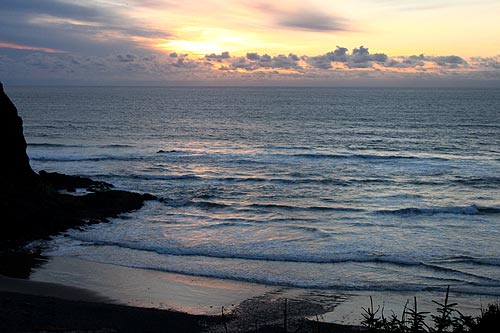State Seeks Input on Which Oregon Coast Beaches to Monitor
Published 04/16/2017 at 4:43 AM PDT
By Oregon Coast Beach Connection staff

(Oregon Coast) – What Oregon coast beaches do you think need to be monitored for health hazards? The Oregon Health Authority (OHA) wants to get public input and opinion.
OHA is taking suggestions until May 8, based on beaches the agency is proposing to be part of its monitoring system during this summer. Beaches are normally monitored from Memorial Day through Labor Day.
OHA's Monitoring Program works with the Department of Environmental Quality (DEQ) to determine beaches that need monitoring based on several established criteria. Among the issues looked at are pollution hazards that may be present, beaches that have had previous water quality issues, type and amount of beach use, and public input.
Includes exclusive listings; some specials in winter
In Cannon Beach:
Includes rentals not listed anywhere else
In Manzanita, Wheeler, Rockaway Beach:
Some specials for winter
In Pacific City, Oceanside:
Some specials for winter
In Lincoln City:
Some specials for winter
In Depoe Bay, Gleneden Beach:
Some specials for winter
In Newport:
Look for some specials
In Waldport
Some specials for winter
In Yachats, Florence
Some specials for winter
The list of 2016 beaches included one or two sections of many beach towns and areas between – but it is not comprehensive. Out of more than 90 separate beaches along the Oregon coast, about 30 were monitored last year. The state has only one full-time beach monitoring professional.
OHA regularly re-evaluates which beaches and sampling locations are used to protect public health. This year, their criteria has led them to propose the following beaches for monitoring in 2017:
Seaside Beach, Cannon Beach and Tolovana State Park Beach in Clatsop County. In Tillamook County, they are proposing Short Sand State Park Beach, Rockaway Beach, Twins Rocks Beach, and Neskowin State Park Beach.
On the central Oregon coast, Lincoln County proposed beaches are Lincoln City's D River State Park Beach; Newport's Beverly Beach, Agate State Park Beach, and Nye Beach; and Seal Rock State Park Beach just south of Newport. The one Lane County beach proposed is Heceta Beach (in Florence).
On the southern Oregon coast, beaches include Bastendorff Beach, Sunset Bay State Park Beach, Hubbard Creek Beach, Harris Beach State Park and Crissey Field State Park. A copy of the 2017 beach evaluation report is available on the OHA website.
The proposed list very similar to last year's, and looks at beaches most frequently visited, where bacteria has been previously found, or which local partners and the public have requested monitoring due to potential pollution concerns.
The list of the 2016 monitored beaches and sampling schedule is available on the program's website.
OHA will accept public comments and suggestions on the proposed 2017 beaches through May 8. Comments can be submitted by email at beach.health@state.or.us or by calling 971-673-0400.
Advisories are issued when test results show bacteria levels are at or above the standard 158 cfu/100ml marine water. They are lifted when results show levels below that, which typically takes 48 hours or so. Most often these are caused by fecal bacteria getting into the water, but it is usually not known exactly what that source is in each instance. One known source for some areas are the large flocks of seagulls that occur when people feed them, and their droppings make it into outgoing streams.





More About Oregon Coast hotels, lodging.....
More About Oregon Coast Restaurants, Dining.....
Cannon Beach Lodging
Nehalem Bay Lodgings
Manzanita Hotels, Lodging
Three Capes Lodging
Pacific City Hotels, Lodging
Lincoln City Lodging
Depoe Bay Lodging
Newport Lodging
Waldport Lodging
Yachats Lodging
Oregon Coast Vacation Rentals
Oregon Coast Lodging Specials
LATEST Related Oregon Coast Articles
Likely just before dawn best hour but peak happens during daylight. Weather
Dark Sky Week is Prime Along Oregon Coast: Where and Where Not to Go
General guide to dark sky viewing from south to north coast. Astronomy
Sizable Price Drop, Deals in Lincoln City During Quiet of April on Central Or...
20 perc off at A1 Vacation Rentals across its roster, including Gleneden Beach. Lincoln City specials
Upcoming S. Oregon Coast Events Include Gem Show, History: Coos Bay, Bandon
May 6 talk at Coos History Museum, Mayfly Fest May 17, Bandon Rock / Gem Show June 7,8
Washington Coast Cleanup on April 19 - Coinciding with Oregon Coast's SOLVE E...
From the Puget Sound to Long Beach, alongside Oregon's cleanup. Washington coast events, Seaside events
Astoria's Riverwalk Gets New Lighting, More N. Oregon Coast Roadwork
Delays coming this summer, but the riverwalk has a new look. Seaside, Cannn Beach
April Gets Even Cheaper Midweek at Depoe Bay, Lincoln City: Oregon Coast Deals
Off-season rates plus more at Keystone Vacation Rentals. Depoe Bay lodging specials, Lincoln City hotel reviews, Newport hotel reviews
Washington Coast Begins Week of Clam Digs, April 12 Through 18
Long Beach, Twin Harbors, Mocrocks and Copalis at different times. Washington coast events
Back to Oregon Coast
Contact Advertise on BeachConnection.net
All Content, unless otherwise attributed, copyright BeachConnection.net Unauthorized use or publication is not permitted













































